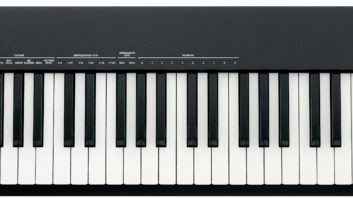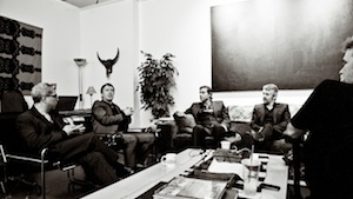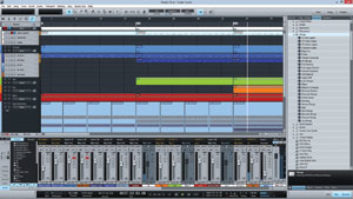This past January, the Winter NAMM show returned to Anaheim,Calif., the home of Mickey Mouse, Knott’s Berry Farm and countlessother institutions dedicated to the proposition that, dammit, youare going to have fun! And I returned, too. The last threeyears, this gigantic music industry trade show, second only inenormity to Frankfurt’s MusikMesse (which I’ve never been to andhave no great desire to go to) has been held in downtown LosAngeles. During that time, the Anaheim Convention Center wasundergoing a giant facelift, and, although it was still open forbusiness, the NAMM powers-that-be decided that it would be —believe it or not — safer to hold the show indowntown L.A., a place where even the taxi drivers won’t wander atnight without a bodyguard. So I have stayed away. But this year, Icame back. And, yes, I did have fun.
A lot of other people came back, too, apparently. The number ofregistrants at the show, which celebrated the 100th anniversary ofthe organization (whose full name is the International MusicProducts Association), was 65,372, which represents a 10% increasefrom last year.
Anaheim hasn’t changed much in the interim, and the“new” convention center isn’t much different from theold one, except there’s now an impressive, but not particularlyuseful, three-story glass lobby occupying the space that used to beoutside, between the convention center and the adjacent HiltonHotel. The remaining sliver of open space, although they’ve triedto soften it with plants, is something of a claustrophobic concretewind tunnel.
Inside, the center is much the same as it’s always been —a cavernous bunker — only they’ve removed most of the wallsseparating the various “halls” so that it feels evenlarger. And it definitely seemed noisier: Even in the acousticguitar and saxophone sections of the building, the ambient SPL waswell up into the New York-subway-at-rush-hour range.
Anaheim, itself, was unusually cold, even for January. When Ileft Boston in the morning, it was 37°, and when I arrivedthat night at my hotel, it was 38°. Southern Californians, whodon’t understand winter, think that the way to warm up a room is toblow electrically heated air into it. So the relative humidityinside the hotels and convention center, already low to begin with(remember, if it wasn’t for all that water coming from north ofSacramento, Orange County would still be a desert), felt like ithad dropped to zero. Bottles of water were selling briskly frommachines on the show floor at $2.25 a pop. It’s no wonder it tookme just one day to come down with a nasty case of “conventionthroat,” or “NAMMyngitis.”
During the week of the NAMM show, there always seems to be somedisaster going on in the outside world. One year, the show begantwo days after the Northridge earthquake. Another year, we went towar with Iraq, and every monitor in the place was tuned to CNN,watching the bombers as if they were a video game. This year, therewas the installation of George II in Washington, but everyoneignored that. The threat of rolling electrical blackouts throughoutCalifornia, however, was harder to ignore, but, thankfully, OrangeCounty was spared that week. I was a little sorry about this— it would have been interesting to see how conventioneers(not to mention Disneyland) would have coped withoutelectricity.
There are two reasons I go to NAMM: I get to see old friends andnew technology. I wasn’t disappointed on either count this time. Iwon’t bore you with the details of my social calendar, but it wasgreat to see fellow Mix columnist Stephen St.Croix, who,although we are separated by but a few sheets of paper every month,I actually get to see in meatspace infrequently. Stephen wassporting his cool new 21st-century short ’do, and, for achange, you could actually see his face, which is really quitepleasant.
As for new technology, there were, of course, lots. This year, Ihappened to be on a particular mission to find“alternative” electronic musical controllers for acourse I hope to teach in the fall, and the show gave me a terrificopportunity to scope out what folks all over the world, incompanies large and small, have been doing in their workshops andlaboratories. My sympathies at any trade show tend to be with thesmallest and most struggling companies, and there were plenty ofthose in attendance. Some of them were showing some pretty coolstuff.
Alternative music controllers have a habit of appearing anddisappearing quickly. It’s tough to get people to agree to learn anew instrument, and making a successful product that requiresplayers to learn a new technique and, God forbid,practice, takes time. That’s something that cash-strappedstartups don’t often have, and so sales of new controllers by smallcompanies, no matter how well-received they might be by the press,rarely reach the critical mass necessary to make theirmanufacturers viable. For me, every NAMM show brings back fondmemories of glorious oddities like Palmtree’s AirDrums (also knownas the “MIDI maracas”); the SynthAxxe, which lookedlike a guitar that had been run over by a truck; and the MIDI“tap shoes,” “dog collar” and stringlessharp from companies whose names I can’t remember.
Larger companies, too, have felt the pressures of the marketwhen it comes to making innovative and unusual instruments, andmany of them have pulled out of that side of the business. But afew have hung in.
Yamaha (www.yamaha.com) has been flying the flag of MIDI windcontrollers for many years, and the company’s latest is the WX5,which, like its predecessors, uses fingerings similar to a flute orsaxophone, with additional knobs and keys to change octaves andoperate pitch bend and other continuous parameters. The WX5incorporates most of the features of earlier WX Series controllers,but the price is considerably lower: $699. Of course, to get themost out of it, Yamaha recommends a pairing with itsphysical-modeling synth module, the VL70M, which is $799.
Roland (www.rolandus.com) has always pursued MIDI drums andguitars, and many of its products have straddled the pro andconsumer music worlds successfully. The latest result is the HPD-15Hand Percussion Pad — let’s call it a “MIDIConga” — and, in fact, they were showing a few of themattached to conga drum shells, but they’re hardly required. TheHPD-15 is a rubber pad with 15 different sections, each of whichcan be programmed to play a different sound. All of the pads havepressure sensing, and the larger pads also have positional sensing,so you can change a sound by pushing on the pad or by moving aroundon it. It also has two ribbon controllers and a“D-Beam” infrared distance sensor, so you can wave yourhands in the air and do weird things to the sound. It comes with600 (!) percussion sounds in ROM and a built-in sequencer, all for$1,300.
Speaking of waving your hands around, Alesis (www.alesis.com)has come up with two nifty little devices, the airSynth and theairFX. Both units look a little like trackballs for an iMac, butthe glass ball in the middle doesn’t move. Instead, it houses aninfrared sensor that detects hand positions in 3-D, usingtechnology that the company has applied for a patent for. They haveno other controls except a program-select dial. The airSynthcontains 50 sounds, while the airFX has 50 filters, time-basedeffects, reverbs and a few synth sounds. At $249 each, these areslated for the DJ market: Both devices have RCA outputs andpass-through inputs, so you can put them in the same signal pathas, say, a CD player without tying up mixer inputs or aux sends.There are no MIDI jacks, so there’s no way to interface the unitswith anything else, but a company representative told me thatAlesis is considering using the technology in MIDI devices in thefuture. I hope they do — it’s way cool, and it would be greatto open it up to other types of performers.
Any discussion of musical hand waving would be incompletewithout mention of Bob Moog’s Theremins. Before there were any Moogsynthesizers, there were Moog-built Theremins. Moog has gone backto his roots, and his company, Big Briar (www.bigbriar.com), wasshowing two of the beasts. The Etherwave Theremin is a classictwo-antennae job, housed in a small box with a vertical pole forpitch and a horizontal loop for volume. It goes for $369, butthere’s also a “Bob Moog Signature” Version for anextra $30, or you can save $70 and buy it as a kit, which comeswith an assembled and pre-tested circuit board, in case yoursoldering chops aren’t what they used to be. At the high end is theEthervox MIDI Theremin ($3,500), which is in a large wood casethat’s modeled after Leon Theremin’s original instrument. It’s avery clever design: As you move toward or away from the pitchantenna, it sends MIDI data in the form of either individual notecommands or pitch bend commands or some combination of the two thatyou can program. It also receives MIDI, so you can record (andedit) your swoopings and play them back.
Besides Moog, one of the pre-eminent names in the early days ofsynthesis was Don Buchla, builder of wonderful nonkeyboard-oriented(which is one reason why it never caught on like Moog’s) modularsystems, named after their creator. I learned all about voltagecontrol and sequencing on one of those beasts in college. Althoughthe old machines are now collector’s items, Buchla, himself, isstill very active and has designed some really interestingelectronic musical interfaces with names like “Thunder”and “Lightning.” His latest creation, the MarimbaLumina, is being marketed by a company called Nearfield Systems(www.multimedia.nearfield.com), which primarily makes radio antennameasurement products but has formed a new multimedia division justto sell this instrument. Much more than a MIDI xylophone, theMarimba Lumina (and its new $1,000-cheaper little brother, thetwo-and-a-half-octave ML2500) has a ribbon controller, 10 controlpads, storage for 50 setups, a built-in Yamaha XG synthesizer, andinputs for seven trigger or controller pedals. It has all kinds ofexpression and duration control, arpeggiation, alternative scalesand much more. The instrument comes with four color-coded,foam-covered mallets, each of which can be programmed separately;so, for example, hitting a note with the red mallet will play onekind of sound, while hitting the same note with the green malletwill play a different sound. You don’t have to be a killerxylophone player to get the most out of this baby, but if the guydemoing it was any indication, it does help.
And speaking of built-in synths, I’ve been writing aboutsoftware synthesis for a number of years, but so far I’ve yet tosee anything that I can put on my computer that I would consider tobe a reasonable replacement for a good general-purpose hardwaresynth module. But the latest version of Native Instruments'(www.native-instruments.de) Reaktor is getting awfully close. The$500 software, which works on Mac and Windows platforms, puts acompletely configurable polyphonic/polytimbral synth, a sampler, adrum machine and a groove generator onto your computer in one fellswoop. Version 3.0, due out this quarter, has a more intuitive userinterface with modules that make the architecture of the systemmuch clearer. To get more than a handful of voices out of it, youneed at least a 400MHz computer, but we all know those aren’t hardto find anymore. The German company has also released a“Junior” Version of the software, called Dynamo, at$200.
A new company from Victoria, B.C., Tactex Controls, is making“digital skin”: fabrics that can detect position andpressure when they are touched. The technology grew out of theCanadian Space Agency (you didn’t even know there was one, didyou?) and is now being applied to touch pads, game controllers,cell phones, “wearable” computers and — youguessed it — musical instruments. The company’s firstmusic-oriented product, the MTC Express, is a hand-sized touch padthat hooks up to a computer through the serial port (or aserial-to-USB converter). At NAMM, Tactex was demonstrating it on aMac using custom objects created in the musical programminglanguage, Max, to do interesting things with sound andspatialization. By itself, the MTC Express sells for $495, but thetechnology was also being shown in a prototype of a configurablemusic and/or mixing controller, called Surface 1 at the MIDIManbooth around the corner. Tactex also says that its fabric will showup as a left-hand controller on a new analog synthesizer that willsoon be introduced by Moog. Max, which was formerly marketed byOpcode, was thankfully spun off before that company’s demise toCycling ’74, which is owned by David Ziccarelli, one of theauthors of the software; his booth was right across the aisle.
Besides weird musical instruments, there were a number of othersomewhat obscure but very exciting technological developmentsunveiled at NAMM that bear reporting. The smallest booth with thebiggest crowd belonged to Celemony Software (www.celemony.com), atiny three-month-old German company that was demoing anearly-in-development voice-processing program called“Melodyne.” It looks very simple: You record a vocal(or solo instrumental) line into it and it shows up graphically onthe screen, with vertical position as pitch, vertical width asvolume and horizontal length as duration. So far, no big deal. Butthen the bearded gentleman doing the demo would grab a note andmove it to another pitch, grab another note and change its durationand reverse the order of two other notes, and you’d swear thesoprano re-recorded her solo with different sheet music — thealgorithm they’re using, whatever it is, is that good. For fourdays, the duo manning the booth played the same demo over and over,but the reaction they got was always, undoubtedly gratifying, thesame: jaws dropped. It will be interesting to see how this evolvesand what it will look like when it comes to market — not tomention how well it works on other program material.
On the other hand, the biggest company with the smallest boothwas Apple Computer. They were in a little room with no chairsupstairs from the show floor, which you had to be told how to find(“turn right at the Pepsi machine”) or else you’d nevermake it. There, industry veteran Kord Taylor, now the company’smusic and audio market manager, was demonstrating a G4 hooked up toone of Yamaha’s new mLAN8P audio/MIDI interfaces for IEEE-1394,also known as FireWire. The two companies have agreed to cooperatein implementing Yamaha’s mLAN “media layer” extensionto the Apple-invented 1394 standard, which could be a significantdevelopment for our industry: Hopefully, it means a much smootherpath for implementation of FireWire — which has already had atremendous impact on the video world — in music, audio andpost-production tools.
Finally, one company was highly conspicuous in its absence fromNAMM. Sonic Foundry, maker of products like Sound Forge, Acid andVegas Pro, which have become standards for audio and video typeswho use Windows, and who, by any reasonable measure, should beconsidered highly successful, was supposed to be occupying a600-square-foot booth in an extremely desirable location right bythe entrance doors. Instead, there were just a few potted plantsand empty chairs.
Three weeks before the show (i.e., the week before Christmas),the company announced it was cutting spending by $20 million, firstby laying off 40% of its staff, and second by canceling its NAMMpresence. In fact, according to the company’s corporatecommunications manager, they will not be at any tradeshows this year and, instead, will be “concentrating ondeveloping new products.” No doubt the downturn in high-techstocks last year had a lot to do with their problems, but still,for a company as well established as Sonic Foundry to have itsstock lose 91% of its value in the past year was prettyastonishing. Some observers were saying that the company’s costlyacquisitions — of a streaming media company and a companythat “repurposes content for international development”— were too far away from its core strengths, as well as toomuch for it financially. Let’s hope the company survives this boutwith economic distress: We’ve seen too many innovative musicsoftware companies bite the dust thanks to greed, recklessness,over-reaching or just plain stupidity.
Speaking of companies that didn’t deserve to die, I’ve receivedquite a bit of mail regarding my little diatribe against Gibson’streatement of Opcode, all of it from folks, like me, who are tryingto continue to use Opcode’s software despite the lack of upgradesand support. Two excellent resources are the Vision Info Site, atwww.fm-music.com/v/, and adiscussion and support group at www.topica.com/lists/opcode-users.
Paul Lehrman is glad to be back home. Visit his home atwww.paul-lehrman.com.







